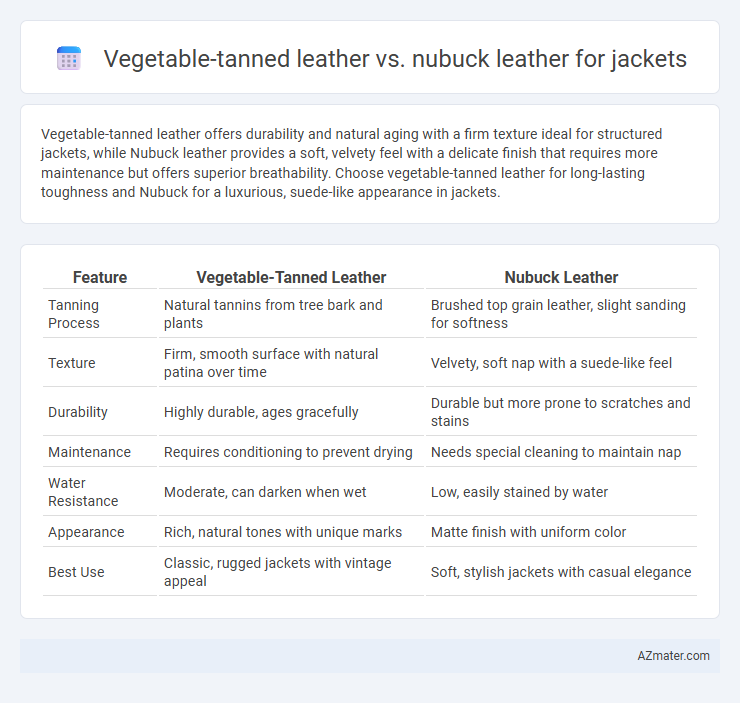Vegetable-tanned leather offers durability and natural aging with a firm texture ideal for structured jackets, while Nubuck leather provides a soft, velvety feel with a delicate finish that requires more maintenance but offers superior breathability. Choose vegetable-tanned leather for long-lasting toughness and Nubuck for a luxurious, suede-like appearance in jackets.
Table of Comparison
| Feature | Vegetable-Tanned Leather | Nubuck Leather |
|---|---|---|
| Tanning Process | Natural tannins from tree bark and plants | Brushed top grain leather, slight sanding for softness |
| Texture | Firm, smooth surface with natural patina over time | Velvety, soft nap with a suede-like feel |
| Durability | Highly durable, ages gracefully | Durable but more prone to scratches and stains |
| Maintenance | Requires conditioning to prevent drying | Needs special cleaning to maintain nap |
| Water Resistance | Moderate, can darken when wet | Low, easily stained by water |
| Appearance | Rich, natural tones with unique marks | Matte finish with uniform color |
| Best Use | Classic, rugged jackets with vintage appeal | Soft, stylish jackets with casual elegance |
Introduction: Understanding Leather Types for Jackets
Vegetable-tanned leather offers durability and a rich, natural patina that develops over time, making it ideal for long-lasting jackets. Nubuck leather, characterized by its soft, velvety surface achieved through sanding the outer grain, provides a luxurious texture and a more casual appearance. Choosing between vegetable-tanned and nubuck leather depends on desired aesthetics, maintenance requirements, and wear resistance for optimal jacket performance.
What is Vegetable-Tanned Leather?
Vegetable-tanned leather is crafted using natural tannins from plant materials like tree bark, leaves, and fruits, resulting in a durable, eco-friendly, and biodegradable material. This tanning process enhances the leather's natural grain and develops a rich patina over time, making it ideal for high-quality jackets that age beautifully. Unlike Nubuck leather, which is sanded for a velvety surface, vegetable-tanned leather maintains a smooth, firm texture that provides excellent strength and long-lasting wear.
What is Nubuck Leather?
Nubuck leather is a top-grain cattle hide that has been sanded or buffed on the grain side to create a soft, velvety surface with a slight nap, providing a plush texture and matte finish ideal for stylish jackets. Unlike vegetable-tanned leather, which undergoes a natural tanning process using tannins from plant sources to enhance durability and develop rich patinas, nubuck leather is typically chrome-tanned, offering more flexibility and resistance to moisture. Nubuck's fine grain and delicate nature require careful maintenance to preserve its aesthetic appeal, making it a premium choice for fashion-forward outerwear.
Appearance and Texture Differences
Vegetable-tanned leather features a smooth, firm surface with a rich, natural patina that deepens over time, giving jackets a classic, rugged look. Nubuck leather, created by sanding the outer grain, presents a soft, velvety texture with a matte finish, offering a more refined yet casual appearance. The difference in texture makes vegetable-tanned jackets more durable and resistant to scratches, while nubuck jackets showcase a delicate touch that requires careful maintenance to preserve their luxurious feel.
Durability and Wear-Resistance Comparison
Vegetable-tanned leather offers superior durability due to its natural tanning process, which enhances fiber strength and resists stretching and cracking over time. Nubuck leather, while softer and more supple, tends to be less wear-resistant because its surface is sanded to create a velvet-like finish that is prone to scratching and staining. For a jacket subjected to frequent use, vegetable-tanned leather provides better long-term wear-resistance and structural integrity compared to nubuck.
Comfort and Breathability Factors
Vegetable-tanned leather offers superior breathability due to its natural tanning process, allowing air circulation that enhances comfort during extended wear. Nubuck leather, sanded on the grain side, provides a soft, velvety texture but tends to be less breathable, potentially trapping heat compared to vegetable-tanned leather. For jackets prioritizing comfort in varying temperatures, vegetable-tanned leather generally outperforms nubuck in moisture management and air permeability.
Aging and Patina: How Each Leather Evolves
Vegetable-tanned leather develops a rich, deep patina over time, showcasing unique color variations and surface wear that enhance its character. Nubuck leather, with its sanded surface, softens and gains a subtle, velvety sheen while darkening slightly, though it shows wear less dramatically than vegetable-tanned leather. Both leathers age gracefully but vegetable-tanned leather offers a more pronounced, personalized transformation in jackets.
Care and Maintenance Requirements
Vegetable-tanned leather jackets require regular conditioning with natural oils or leather creams to prevent drying and cracking, while Nubuck leather jackets need gentle brushing with a soft brush to maintain their velvety surface without damaging the nap. Both types benefit from waterproofing sprays to protect against stains and moisture, but Nubuck is more prone to water marks, demanding careful drying away from direct heat. Proper storage in a cool, dry place and avoidance of prolonged sunlight exposure help preserve the color and texture of both leather varieties.
Environmental Impact and Sustainability
Vegetable-tanned leather uses natural tannins from plant sources, making it biodegradable and less harmful to the environment compared to chrome-tanned leather, which is common in Nubuck production. Nubuck leather, often chrome-tanned, involves toxic chemicals that can pollute water sources and are less sustainable due to slower decomposition rates. Choosing vegetable-tanned leather for jackets supports eco-friendly practices by reducing chemical waste and promoting renewable, biodegradable materials.
Choosing the Right Leather for Your Jacket
Vegetable-tanned leather offers durability and develops a unique patina over time, making it ideal for those seeking a natural, rugged look in a jacket. Nubuck leather, with its soft, velvety surface and lightweight feel, provides a luxurious texture but requires more care to maintain its appearance and resist stains. Choosing between vegetable-tanned and nubuck leather depends on your preference for durability versus softness and the level of maintenance you are willing to commit to for your jacket.

Infographic: Vegetable-tanned leather vs Nubuck leather for Jacket
 azmater.com
azmater.com